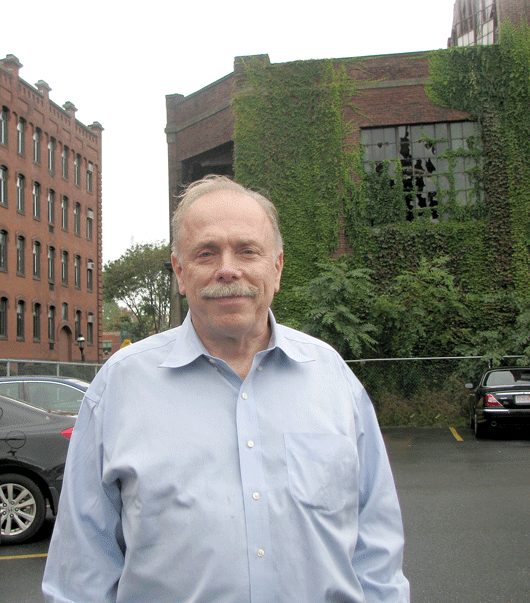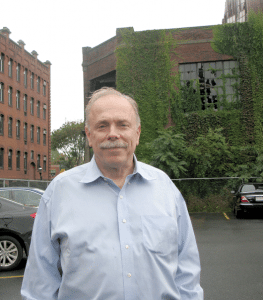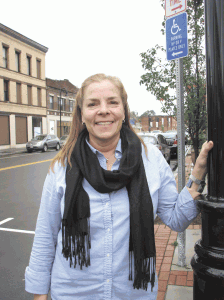
Timing Pattern
Springfield’s Rebuilding Effort Comes at Intriguing Time for Urban Centers

Dave Dixon says there is a surge in interest in urban living, which presents huge opportunities for cities like Springfield.
Dave Dixon was understandably wary about incorporating the phrase ‘silver lining’ into any statements he made concerning the June 1 tornado and its aftermath.
But he nonetheless put it to use as he talked about the efforts to rebuild Springfield and, more specifically, the work to revitalize the downtown and South End sections of the city. And that silver lining is all about timing and emerging trends in urban centers, he explained.
“If this tornado had struck 10 years earlier, let’s say, I think this would be a much grimmer task, because we’d be rebuilding in the face of continuing disinvestment in the city,” said Dixon.
He’s the principal in charge of planning and urban design at Goody Clancy, the Boston-based architecture, planning, and preservation firm now co-leading the efforts to blueprint a rebuilding plan for Springfield with New Orleans-based Concordia (see related story, page 62).
Elaborating, Dixon said that, over the past several years, there has been a discernable upswing in the popularity of urban living. Spawned by a number of factors, including a desire among aging Baby Boomers to live in places where they can walk rather than drive to most required destinations, the trend has helped transform a number of urban centers, many with the same social and economic challenges as Springfield’s central business district and South End.
“Ten years ago, the world didn’t look like this,” said Dixon, who has seen or helped orchestrate revivals in cities ranging from Baltimore to New Orleans to Wichita, Kan. “This disaster in Springfield, like the one in New Orleans, happened at a time when cities are changing and have opportunities that they haven’t had for 40 or 50 years.
“What has gone on, particularly over the past decade, has been a profound transition in demographics, in the way real-estate markets work, in the values that the folks who bring investment with them because they attract employers, have all undergone,” he continued, adding that there are more single individuals or couples (as opposed to families) than was the case a decade ago, and income levels for such people are higher. “There are simply more people that could decide they want to live in an urban environment. They may have wanted to in the past, but it didn’t work for them. And now they’re looking to make it work.”
Indeed, the real silver lining for Springfield, said Dixon, is an apparent, and growing, pent-up demand for downtown mailing addresses. To illustrate, he took out a piece of paper and sketched a simple chart showing the rising popularity of urban living.
The line moves upward at a steady clip, he explained while drawing, but the recession of the past several years has restricted the angle of ascent because, among other factors, homeowners looking to relocate to urban centers are still having trouble selling their homes, and market-rate housing builders are still being challenged in their efforts to finance such endeavors.
Like a dam holding back water, these factors are effectively bottling up demand, he continued, adding that, when conditions improve and that figurative dam breaks, cities properly positioned to capitalize on the trend could benefit significantly.
And in many ways, the tornado has helped put Springfield in such a position, he went on, acknowledging that the city still faces a number of challenges in this regard — including crime, the perception of same, and a concentration of subsidized-housing projects in both the downtown and South End — and that progress certainly won’t occur overnight.
But the city has many of the key ingredients to join the list of other success stories, he said, listing a decent “walkability index” — more on that later — a solid existing inventory of buildings that can be converted into market-rate housing, and, thanks to the tornado, some vacant acreage on which to build such housing, as well as businesses to sustain an urban population.
Dixon acknowledged that many are skeptical that such urban living could help transform Springfield’s downtown area, but he’s seen enough evidence of the trend in other parts of the country to believe it could certainly happen here.
Walking the Walk
As he talked with BusinessWest, Ron Mallis, a senior planner with Goody Clancy, was using his iPhone to see how well several downtown Springfield addresses fared on a Web site called walkscore.com. The site essentially assesses a location based on one’s ability to walk to amenities ranging from coffee shops to entertainment venues to banks, and gives it a score from 1 to 100, with the latter being the best.
The DevelopSpringfield office at 1182 Main St. earned an 89, while the Red Rose restaurant just a few blocks south notched an 82. Those statistics are not to be discounted, said Mallis, because many constituencies, from young artists to aging Boomers to business owners, are looking at such numbers with greater interest.
“People are more health-conscious than they were years ago,” he explained. “People have woken up to the fact that walking and health have a direct correlation, and that certainly plays a part in the decisions people are making about where they want to live.
Dixon agreed. “If you look at surveys about how much people want to drive, it used to be that, the younger you were, the more you liked getting in the car and driving; now it’s the reverse, and some of it is health-driven; it’s viewed as unhealthy to be in a car a lot.”
But there’s more to this trend than exercise, he continued, adding that many individuals within different age groups, when queried about what they want from a residential address, put that intangible ‘community’ high on their list. “And people think of urban areas as offering much more opportunity for community — to run into each other and meet each other.
“When you look at the top-10 criteria that people listed for where they wanted to live, from the ’60s up until probably 2003, or at least through the ’90s, it was golf courses, near golf courses, on a golf course, and as far away from work as possible,” he went on. “None of those are on the list in 2011. Surveys now show it’s proximity to Main Street, diversity, the ability to walk to work … and even telecommuters are much more interested in living in denser, walkable areas, perhaps because they spend the day by themselves.”
Dixon and Mallis have seen such trends emerge as they’ve helped Goody Clancy compile an extensive portfolio of work in older urban areas. The firm has taken part in a number of downtown projects, from guiding 12 million square feet of mixed-use development around the Massachusetts Institute of Technology to revitalization plans for communities as such as Baltimore, Akron, Ohio, Jamestown, N.Y., and, locally, Greenfield.
To illustrate his point on urban living and add a measure of credibility to the argument, Dixon pointed to Wichita, a city of about 900,000 and a downtown still fighting its way back from decades of disinvestment and an out-migration of people and businesses.
“Even the lawyers moved out of the downtown, which is unusual,” he said. “Compared to many parts of downtown Wichita, Springfield’s South End would look cool — it would look like an arts district. But downtown is beginning to take off; there are several hundred units of new, cool lofts — they’re rentals right now because the condo market isn’t there yet; one was rented out before it was finished, and another, more expensive building is almost rented out.
“Meanwhile, there’s another, more conventional project with larger, more expensive units that’s just sitting there because that’s not what the market’s going to come back to,” he went on. “The market’s about cool, urban, walkable living spaces. It’s more about living near a cool bakery than it is about giving a view.”
In Springfield, the firm has been assigned the task of coordinating efforts to develop strategic initiatives focused on the downtown and South End, one of three areas, or districts, of concentration involving neighborhoods impacted by the tornado. Since being hired in September, the firm’s representatives have undertaken a general inventory of this sector’s assets and liabilities, said Dixon, adding that there are more of the former than many people might think, and some could help the city take advantage of the pendulum moving back toward urban living.
And in many ways, the city is already making some strides, said Mallis, noting efforts to attract artists to the Morgan Square apartment complex (see BusinessWest, Aug. 29), and other initiatives to create more market-rate housing at several downtown-area properties.
As for the South End, Dixon said it has the potential to be “a hip place,” given its diversity, solid walk scores, proximity to many restaurants and cultural attractions, and decent inventory of properties that could, with some imagination, entrepreneurial flair, and requisite demand, be retrofitted into housing units.
As he walked with BusinessWest down Main Street, Dixon pointed out several such buildings near an already-thriving market-rate complex, the Willows, created from the former Milton Bradley manufacturing complex off Union Street. He gestured to everything from office and retail properties with large vacancy rates to abandoned or underutilized manufacturing and warehouse structures.
“You can just look at those properties and see that, if the market is there a half-block away,” he said, “it can be at those sites as well.”
There are also several currently vacant parcels, including the former Gemini site and some others created by the tornado, which provide opportunities for developers with vision.
Beyond vacant lots, though, the tornado has provided a spark for the city, said Dixon, when pressed about why market-rate housing and related developments haven’t happened sooner.
“As horrible and painful as the tornado has been for many people,” he said, “it has sort of galvanized the moment; it has the community focused, the city focused, everybody focused on how to rebuild better.”
Building Momentum
This combination of focus and determination has arrived at the intersection of rising interest in urban living and pent-up demand. It’s an intriguing situation that could make Springfield’s downtown the right place at the right time.
“Put all these things together, and Springfield, like many cities, has opportunities that it hasn’t had for a very long time,” said Dixon. “They don’t happen automatically, though. Cities have all these problems — fragmented land ownership, zoning, tax structures — which are not necessarily geared to the kind of development you want, and crime and the perception of crime.
“But there are lot of cities that have been very patient over the past 10 years, looking at what’s happening, removing the obstacles, investing in downtowns, and getting tremendous payoffs. Springfield has that opportunity; something like the tornado is a kind of wakeup call that it’s not just time to change, but to take stock. And when you take stock, you can take advantage of these opportunities.”
In other words, this could a silver lining that makes Springfield a shining example of how urban centers can be revitalized.
George O’Brien can be reached at [email protected]
Involvement, Strong Leadership Called Keys to Rebuilding Effort

Bobbie Hill says plans and process are important, but involvement and leadership are the keys to revitalizing a city.
And she said there will be all three when it comes to the task of rebuilding Springfield in the wake of the June 1 tornado. However, none will be the real key to a successful effort.
Instead, the most vital component — and she says she’s learned this from considerable experience — is getting the residents of the community in question to take a real ownership stake in the recovery initiatives.
“It’s the relationship-building, the community-capacity-building, the taking-ownership piece,” said Hill, a consultant with the New Orleans-based planning and architecture firm Concordia, which is heading the team of companies coordinating Springfield’s rebuilding-plan process. “Those are the keys; it’s ownership, and holding yourself, your neighbors, elected officials, and developers accountable to doing it and doing it right.
“That engagement component, that people component, is as important if not more important than individual concepts,” she continued. “This can’t just be about development projects; that’s not what transforms a community.”
What does, she stressed again, is a willingness on the part of residents to get involved and stay involved, and not give in to the theory, or temptation, that government will take care of things. And it comes through leadership, she went on, noting that, in most every community where the 11-person firm has lent its disaster-response, planning, and design expertise, leaders from the community have emerged.
The process of getting the community involved in the rebuilding effort began earlier this month with neighborhood meetings in the three identified sectors involving areas of the city damaged by the tornado. Sector 1 is the metro center (downtown) and the South End, while Sector 2 is composed of Six Corners, Upper Hill, Old Hill, and Forest Park, and Sector 3 includes Sixteen Acres and East Forest Park.
Those neighborhood meetings were followed up with a city-wide gathering a few days later, and two more sessions of neighborhood meetings and another city-wide session are scheduled for November and December, said Hill, adding that the four firms collaborating on the endeavor will present an implementation and financing plan to a community congress on Jan. 5.
That’s the process, in simple terms, she said, adding that it’s too early to discuss specific potential redevelopment projects, although plenty of suggestions — from a supermarket to market-rate housing projects to reforestation proposals — have come forth at the neighborhood sessions.
In subsequent neighborhood meetings, the suggestions will be discussed at greater length, and eventually priorities will be established, and consultants will “put numbers” to potential recommendations in an effort to determine which ones make sense and which ones don’t.
More importantly, though, the initial sessions have yielded evidence of the requisite level of involvement, leadership, and community spirit that will be necessary for a successful recovery effort.
“I was really encouraged by what I saw and heard the other night,” she referring to the neighborhood meeting in Sector 2. “There was definitely a strong sense of community, people really caring for other and celebrating diversity — that really came across.”
There are four firms involved in the process of coordinating the neighborhood meetings and compiling the report to be completed Jan. 5. They are:
• Corcordia, which, among other projects in its portfolio, led coordination for the Unified New Orleans Plan after Hurricane Katrina that included selection and management of 12 national, regional, and local planning firms that created plans for 14 planning districts and an overall city-wide recovery plan;
• Goody Clancy, a Boston-based urban planning and design firm that has coordinated revitalization efforts in a number of major cities (see related story, page 60);
• Berkebile Nelson Immenschuh McDowell Inc. (BNIM), considered the most experienced firm in the country when it comes to helping tornado-impacted communities engage in a transformative recovery planning process; and
• The Project for Public Spaces (PPS), a nonprofit planning, design, and educational organization dedicated to helping people create and sustain public places that build stronger communities.
For more information on the process or to submit ideas online, visit www.rebuildspringfield.com. The schedule for future neighborhood and citywide meetings is as follows:
• Six Corners, Upper Hill, Old Hill, and Forest Park: Nov. 15, 6:30 to 9 p.m. at the J.C. Williams Center, Florence Street;
• Sixteen Acres, East Forest Park: Nov. 16, 6:30 to 9 p.m. at the Holy Cross gymnasium, Plumtree Road;
• Metro Center, South End: Nov. 17, 6:30 to 9 p.m. at the Gentile Apartments Community Room, Williams Street;
• Metro Center, South End: Dec. 6, 6:30 to 9 p.m. at the Gentile Apartments Community Room, Williams Street;
• Sixteen Acres, East Forest Park: Dec. 7, 6:30 to 9 p.m. at the Holy Cross gymnasium, Plumtree Road;
• Six Corners, Upper Hill, Old Hill, and Forest Park: Dec. 8, 6:30 to 9 p.m. at the J.C. Williams Center, Florence Street;
• City-wide: Dec. 10, 8:30 to 11:30 a.m. at the MassMutual Center; and
• Community Congress: Jan. 5, 6:30 to 9 p.m. at the MassMutual Center.
— George O’Brien





